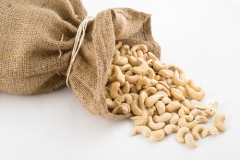
They were called “cashew apples.” Brazil, where “there are many wild monkeys in the forests,” gave this plant to the Indians at the beginning of the 20th century (one could say, Indians to Indians, “to a brotherly friendly people with best wishes!”).
In general, the Indians planted it on the slopes with one goal – to fix the fertile soil carried away from the mountains. The Brazilian immigrant surprised the locals with his fruits, similar to a two-story house (not in size, of course) – a sickle-shaped nut ripened on a juicy, apple-like, red or yellow stalk.
Cashew
(cashew), Anacardium orientalis, “Indian nuts”
Anacardium occidentale L.
Family Anacardiaceae
The Indians quickly got used to the “two-story” fruits. The nuts were fried – often in an abundance of boiling vegetable oil – peeled, and then enjoyed, adding a little sugar for a better taste. But they still loved the “apples” more. They turned out to be sweeter than sugar beets, and had almost as many vitamins as apricots.
An evergreen tree with a gnarled, knotty crown, smaller in size than our rowan tree, unfortunately does not grow here in the temperate latitudes. Its homeland is the subtropics. Nevertheless, the anacardium can easily do without water for half a year and survives where all other trees die. That is why the Indians became interested in it at one time.
Cashew nuts replace more expensive almonds for people. Although some believe that cashews are of worse quality. In any case, bright bags of cashew nuts, once appearing in kiosks, supermarkets, along with chips and peanuts, confidently entered our lives, elbowing aside familiar food.
The first Europeans to appreciate cashew were, of course, the Portuguese. They introduced it into culture in other tropical countries, which they turned into colonies for several centuries. Gradually, the scale of its cultivation outside the “historical homeland” significantly exceeded the cultivation of the plant in Brazil itself (a similar story is with coffee and tea, which found a new homeland far beyond the historical one). Many “Indian nuts” were exported to the Soviet Union and Western countries – for example, in 1964, more than eleven tons of exotic fruits arrived in the USSR.
The cashew fruit is a kidney-shaped nut, located, as we already know, on an expanded, pear-shaped stalk. The seed is shaped like a nut. The expanded pear-shaped stalk (the so-called “apple”), topped with a nut, has a sweet and sour astringent taste, is used fresh or is used to make jelly, preserves or jam, kaju wine. In terms of vitamin C content, the stalk significantly exceeds lemon, and in terms of vitamin B2 content, it exceeds orange.
From the honeycombed greenish-brown shell of cashew nuts, which contains more than 30% of acrid juice, which irritates the mucous membrane of the oral cavity and causes blisters on the tongue and lips, one can obtain a very valuable liquid resinous oil – cardoil. It was successfully used (and continues to be used) to treat leprosy and is used in many ways in technology – for example, in the manufacture of moisture-resistant varnishes, in the production of cables as an insulating material (recently replaced by plastics), and wood etched with cardoil gains the ability to resist attacks by termites.
Cashew nut kernels are eaten after roasting, which destroys any remaining resinous substances, or are used to make various types of confectionery.





